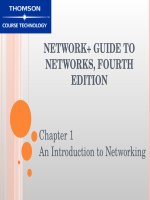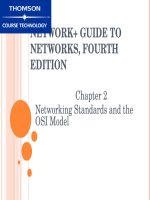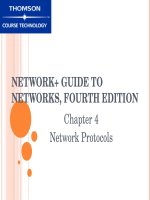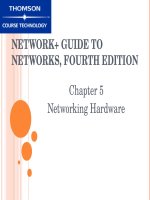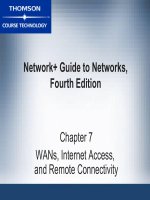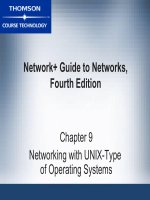NETWORK+ GUIDE TO NETWORKS, FOURTH EDITION - CHAPTER 15 docx
Bạn đang xem bản rút gọn của tài liệu. Xem và tải ngay bản đầy đủ của tài liệu tại đây (492.41 KB, 50 trang )
Network+ Guide to Networks,
Fourth Edition
Chapter 15
Implementing and Managing Networks
Network+ Guide to Networks, 4e 2
Objectives
•
Describe the elements and benefits of project
management
•
Manage a network implementation project
•
Understand network management and the
importance of baselining to assess a network’s
health
•
Plan and follow regular hardware and software
maintenance routines
•
Describe the steps involved in upgrading network
hardware and software
Network+ Guide to Networks, 4e 3
Project Management
•
Managing staff, budget, timelines, and other
resources and variables to achieve specific goal
within given bounds
•
Attempts to answer at least following questions:
–
Is proposed project feasible?
–
What needs must project address?
–
What are project’s goals?
–
What tasks are required to meet goals?
–
How long should tasks take, and in what order
should they be undertaken?
Network+ Guide to Networks, 4e 4
Project Management (continued)
•
Attempts to answer at least the following questions
(continued):
–
What resources are required, and how much will
they cost?
–
Who will be involved and what skills are needed?
–
How will staff communicate?
–
After completion, did project meet stated need?
•
Most projects divided into phases
•
Milestone: reference point marking completion of
major task or group of tasks in project
Network+ Guide to Networks, 4e 5
Project Management (continued)
Figure 15-1: Project phases
Network+ Guide to Networks, 4e 6
Determining Project Feasibility
•
Feasibility study outlines costs and benefits of
project
–
Attempts to predict whether it will yield favorable
outcome
–
Should be performed for any large-scale project
before resources committed
Network+ Guide to Networks, 4e 7
Assessing Needs
•
Needs assessment: process of clarifying reasons
and objectives underlying proposed change(s)
–
Interviewing users
–
Comparing perceptions to factual data
–
Analyzing network baseline data
Network+ Guide to Networks, 4e 8
Assessing Needs (continued)
•
Needs assessment may address the following:
–
Is expressed need valid or does it mask a different
need?
–
Can need be resolved?
–
Is need important enough to allocate resources to its
resolution? Will meeting it have measurable effect on
productivity?
–
If fulfilled, will need result in additional needs? Will
fulfilling it satisfy other needs?
–
Do users affected by the need agree that change is a
good answer? What kind of resolution will satisfy
them?
Network+ Guide to Networks, 4e 9
Setting Project Goals
•
Project goals help keep project on track
–
Necessary when evaluating whether project was
successful
•
Popular technique is to begin with broad goal,
narrow down to specific sub-goals
•
Project goals should be attainable
–
Feasibility study helps determine attainability
•
Sponsors: managers and others who oversee
resource allocation
•
Stakeholder: any person affected by the project
Network+ Guide to Networks, 4e 10
Project Planning
•
Project plan: organizes details of a project
–
e.g., timeline and significant tasks
–
May use text or spreadsheet documents for small
projects
–
For large projects, use project management software
•
Provides framework for inputting tasks, timelines,
resource assignments, completion dates, and so on
Network+ Guide to Networks, 4e 11
Project Planning (continued)
Figure 15-2: A project plan in Microsoft Project
Network+ Guide to Networks, 4e 12
Tasks and Timelines
•
Project should be divided into specific tasks
–
Divide large tasks into sub-tasks
–
Assign duration, start date, finish date to each task
and sub-task
–
Designate milestones, task priority, and how timeline
might change
•
Allow extra time for significant tasks
•
Gantt chart: popular method for depicting when
projects begin and end along a horizontal timeline
Network+ Guide to Networks, 4e 13
Tasks and Timelines (continued)
Figure 15-3: A simple Gantt chart
Network+ Guide to Networks, 4e 14
Communication
•
Project manager responsible for facilitating regular,
effective communication among project participants
–
Must communicate with stakeholders as well
•
Must prepare users for changes:
–
How access to network will be affected
–
How data will be protected during change(s)
–
Whether you will provide means for users to access
the network during change(s)
–
Whether users will have to learn new skills
Network+ Guide to Networks, 4e 15
Contingency Planning
•
Even meticulously planned projects may be
derailed by unforeseen circumstances
•
Contingency planning: process of identifying steps
that minimize risk of unforeseen events that could
affect quality or timeliness of project’s goals
Network+ Guide to Networks, 4e 16
Using a Pilot Network
•
Pilot network: small-scale network that stands in for
a larger network
–
Used to test changes before applying to enterprise
–
Should be similar enough to closely mimic larger
network’s hardware, software, connectivity, unique
configurations, and load
•
Tips for creating realistic and useful pilot network:
–
Include at least one of each type of device that might
be affected by the change
–
Use same transmission methods and speeds as
employed on your network
Network+ Guide to Networks, 4e 17
Using a Pilot Network (continued)
•
Tips for creating realistic and useful pilot network
(continued):
–
Try to emulate number of segments, protocols, and
addressing schemes in current network
–
Try to generate similar amount of traffic
–
Implement same server and client software and
configurations as found in current network
–
Test for at least 2 weeks
Network+ Guide to Networks, 4e 18
Testing and Evaluation
•
Test after completing each major step
•
Must establish testing plan
–
Including relevant methods and criteria
•
Testing should reveal:
–
Whether task was successful
–
Unintended consequences
–
Whether new needs exposed
Network+ Guide to Networks, 4e 19
Network Management
•
In broad terms, assessment, monitoring, and
maintenance of all aspects of a network
•
Network management applications may be used on
large networks
–
Continually check devices and connections to
ensure they respond within expected performance
threshold
–
May not be economically feasible on small network
•
Several disciplines fall under heading of network
management
–
All share goal of preventing costly downtime or loss
Network+ Guide to Networks, 4e 20
Obtaining Baseline Measurements
•
Baseline: report of network’s current state of
operation
–
Baseline measurements allow comparison of future
performance increases or decreases caused by
network changes with past network performance
•
The more data gathered while establishing the
baseline, the more accurate predictions will be
•
Several software applications can perform
baselining
Network+ Guide to Networks, 4e 21
Obtaining Baseline Measurements
(continued)
Figure 15-4: Baseline of daily network traffic
Network+ Guide to Networks, 4e 22
Obtaining Baseline Measurements
(continued)
•
Baseline assessment should address:
–
Physical topology
–
Access method
–
Protocols
–
Devices
–
OSs
–
Applications
Network+ Guide to Networks, 4e 23
Performance and Fault Management
•
Performance management: monitoring how well
links and devices are keeping up with demands
•
Fault management: detection and signaling of
device, link, or component faults
•
Organizations often use enterprise-wide network
management software
–
At least one network management console collects
data from multiple networked devices at regular
intervals
•
Polling
Network+ Guide to Networks, 4e 24
Performance and Fault Management
(continued)
•
Each managed device runs a network
management agent
–
Collects information about device’s operation and
provides it to network management application
•
Definition of managed devices and data collected
in a Management Information Base (MIB)
•
Simple Network Management Protocol (SNMP):
TCP/IP protocol used by agents to communicate
Network+ Guide to Networks, 4e 25
Performance and Fault Management
(continued)
Figure 15-5: Network management architecture
